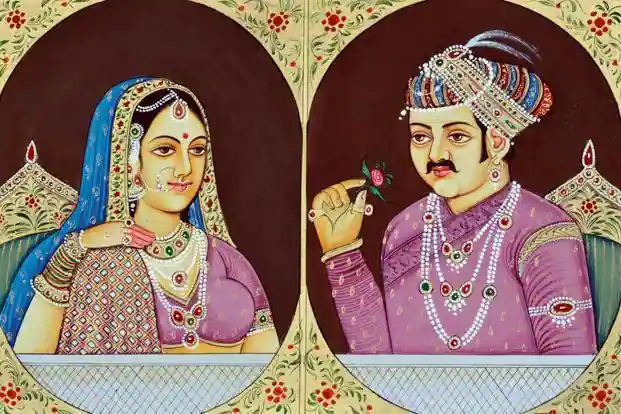Introduction
The Mughals built their empire in the Indian subcontinent from the sixteenth to the eighteenth centuries. They mostly achieved this through military conquests, but they continued to solidify their position by keeping diplomatic ties with other kingdoms. When the Mughal kingdom reached its pinnacle, other kingdoms began to recognise its authority, formed allies with the Mughal emperor, and merged with the Mughal empire. The rulers who readily merged with the Mughal empire was respected and honoured. In this way, the Mughal empire grew and ruled most parts of India for a very long time.
Mughal Relations with other rulers
- The Mughal state began to prosper and eventually attained its zenith. They adopted a policy of conquering kingdoms that refused to recognize their rule through military operations.
- However, many nations accepted the Mughal empire’s subjection after learning of their strength and splendour.
- The Mughals honoured the devotion of such kings who accepted their authority during the construction of the Empire.
- The Mughals let them keep their privileges in place of paying annual tributes, and on the other hand, gave members of that clan important positions in the court.
- In this way, the Mughals maintained a balance of power by not humiliating kingdoms that were annexed and submerged into the Mughal empire.
- Mughals had an extraordinary relationship with the Rajputs, this was so because King Akbar considered Rajputs as the primary concern which can hinder the growth of the Mughal Empire.
Mughal relations with Rajputs
Regarding Mughal connections with the Rajputs, it was Akbar who realized that the Rajputs’ assistance was essential for expanding and consolidating his kingdom.
Prior to him, Babur and Humayun had no clear policy to embrace the Rajputs; instead, Babur grew their empire by overthrowing Rana Sanga (of Mewar) and Medini Rai (Chanderi). Similarly, Humayun was also unable to maintain cordial ties with Rajputs despite his marriage to a Rajput princess and Rani Karmavati (of Mewar’s) offer to accept him as a brother.

He made an effort to gain the Rajput’s trust in the following ways:
- The specific Rajput policy was developed by Akbar as a part of his empire-building efforts.
- He cultivated his relationships with Rajput’s through marriages. He married several Rajput princesses.
- He also married off his son, prince Salim, to the daughter of Bhagwan Das of Amber.
- Rajput lords like Raja Todar Mal, Raja Birbal, and Raja Man Singh received significant posts in his army and government.
- He allowed the Rajput rulers that they could retain their kingdom and continued to rule by accepting Akbar’s overlordship and paying him regular tributes.
- Akbar adopted a wise strategy of refraining from interfering in the internal issues of the Rajputs.
- Rajputs were permitted to practise their religion, construct temples, and participate in festivals during King Akbar’s rule.
- King Akbar also abolished jizyah and won the trust of various Rajputs.
- Not all Rajputs embraced Mughal rule or made friends with them; some Rajput kingdoms posed a serious threat to the Mughals and had to be forcibly incorporated into the Mughal Empire.
- Even though these kingdoms were defeated, these Rajputs were not humiliated; rather, they were honoured, and their territory was given to them as watan jagir during Akbar’s reign.
King Akbar is referred to as “the real founder of the Mughal Empire” since his this Rajput policy during the 16th and 17th centuries was one of the key causes of the Mughal empire’s stability and continued expansion.

Summary
The way the Mughals interacted with other kings was crucial to the growth and stabilization of the Mughal Empire. Babur and Humayun held a neutral view of other kings, particularly Rajput’s, as they did not see them as the main obstacle to the empire’s growth. But after Akbar came to power, the Mughals’ perspective on Rajput’s started to alter. As a result, he maintained cordial ties with Rajput’s by granting them special privileges because he saw them as the greatest threat to the Mughal empire. King Akbar respected and honoured all the various clans which had surrendered to the Mughal empire, he not only gave those emperors respectable positions in the Mughal court but despite of conquering their land he allowed the respective rulers to run their own kingdom. Jahangir and Shajahan kept this liberal attitude toward Rajput’s, but as Aurangzeb came into power he destroyed all relations with the Rajput’s and brought the downfall of the Mughal empire.
Frequently Asked Questions
1. Explain the term Watan Jagir.
Ans: Watan jagir is the name for the substantial autonomy that the Rajput chieftains received in their native regions even after the Mughals took control of the region, provided that they were willing to recognise Mughal rule.
2. What was Aurangzeb’s religious policy?
Ans: The fundamental goal of Aurangzeb’s strict religious policy was to convert India into an Islamic nation. For that he did the following-
- He took anti-Hindu measures like destroying temples, imposing jizyah, and expelling Hindus from important posts.
- He urged individuals to become Muslims to be exempt from numerous taxes.
- His religious policies caused a great deal of division and sparked a number of revolts by Rajputs, Sikhs, Jats, and Satnamis.
3. What does sovereignty mean to you?
Ans: The term “sovereignty” describes the absolute power of one person to run a state.